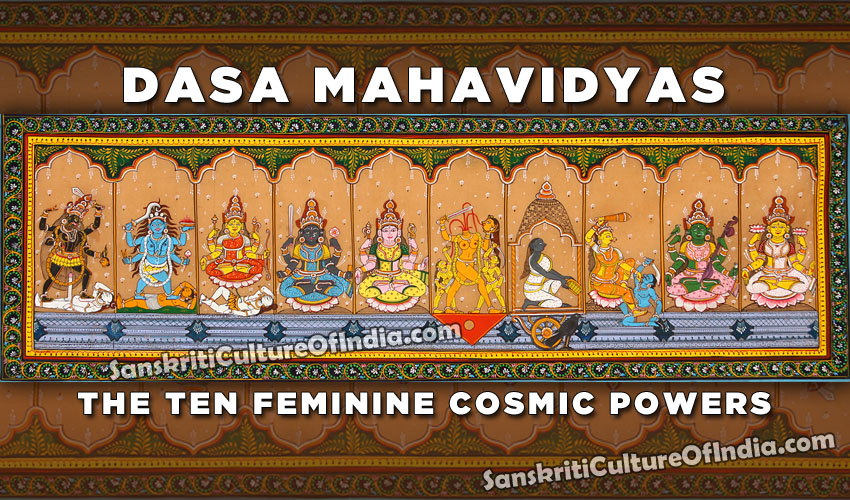A very learned friend recommended the book, The Ten Great Cosmic Powers (Dasa Mahavidyas) to me. It explains the concept of the Maha Vidyas simply and well. Also gives you the deeper significance for each form and look of Shakti. Below is a brief about the book:
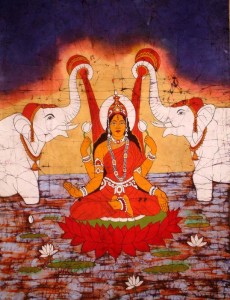
Preface by Shri M.P. Pandit
In his classic exposition of sri vidya and the sri cakra, Sri Shankaranarayanan has dwelt upon the manifestation of the Primal Divine Shakti in the form of this variegated, many-planed Universe. In the present work he explains the process of this manifestation. For, as he points out, creation is not a sudden precipitation; it is a graded self-revelation. The transcendent and ultimate Mother of the Universe puts out several Powers and Personalities of herself, each missioned to work out a particular trusth of her being. Of these, some are the major, Cardinal Powers, mentioned variously as Four, six, Ten, Twelve etc., according to the standpoint of the Seers of old. The Tantra celebrates the Ten as the maha vidyas. Great Sciences, that hold the creation in their celestial grasp.
What are these mahavidyas? Why are they distinguished from one another though they all proceed from and lead to the same on Reality? The author explains with his usual lucidity: “Each is a particular Cosmic function and each leads to a special realization of the One Reality. The might of Kali, the sound-force of Tara, the beauty and bliss of Sundari, the vast vision of Bhuvaneshwari, the effulgent charm of Bhairavi, the striking force of the Chinnamasta, the silent inertness of Dhumavati, the paralyzing power of Bhagalamukhi, the expressive play of Matangi and the concord and harmony of Kamalatmika are the various characteristics, the distint manifestations of the Supreme Consciousness that has made this creation possible. The Tantra says that the supreme can be realised at these various points.
The secrets of these vidyas are buried deep in Sastras and oral traditions. To Sri Shankaranarayanan we owe gratitude for his intuitive grasp of these fundamentals, deep learning and conscientious scholarship in working out the clues and the facility with which he has been able to link up the dateless past of the mystics with the actual present dominated by empirical Science. He also integrates this Thought of the Tantra with the Doctrine and Practice of Life Divine as presented by Sri Aurobindo in his Epic, Savitri.
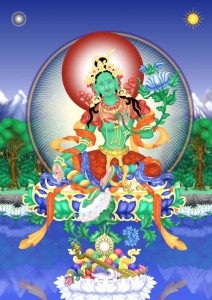
The Book Contents Are:
1. Disciplines of Knowledge
2. Kali
3. Tara
4. Tripurasundari
5. Bhuvaneshwari
6. Tripura Bhairavi
7. Chinnamasta
8. Dhumavati
9. Bagalamukhi
10. Matangi
11. Kamalatmika
12. Correspondence with other Disciplines
13. Sadhana
14. Synthesis
Chapter 1 Disciplines of Knowledge
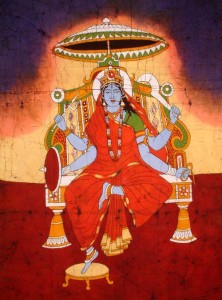
He had studied the Vedas. Like all vaidiks of his time he took to priesthood and was eking out a living. Driven by poverty he approached someone to teach him a Mantra for getting rich quickly. Having got the Mantra, he took his seat in the front courtyard of his house and began practicing the repetition of the Mantra. Two hours would have passed and the Vaidik saw a beggar woman at attempt to drive her away as he did not want his japa to be interrupted by some words spoken in between. The beggar woman who was in tatters stooped down, patiently untied the knots of a bundle of rags, took out the small coins kept there and before the Vaidik knew what she was doing, threw the coins at his feet. The Vaidik naturally was taken aback and began to remonstrate. “Why, you have been asking for this for the past two hours” said she and went her way. The Vaidik stopped repeating his Mantra in sheer disgust and vowed that never again would he go after such pursuits.
This incident which happened years ago is quoted here for the flood of light it throws on certain basic principles of Tantra Shastra. Evidently, the man contacted with the help of the formula given to him an entity or a spirit, a low class of deity which caught hold of the human vehicle of the beggar woman and within two hours made her part with the pittance she had in favour of the man. The deity responded quickly, as being in the lower rungs of the cosmic ladder nearest to the earth-plane it was within easy reach of human beings; and its power was limited to grant only so much of money to the one who called for its assistance.
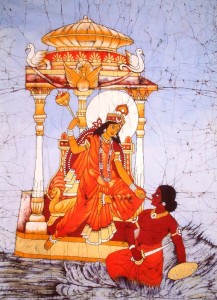
The Tantra recognizes the one Supreme Deity presiding over everything as the Highest, at the same time admitting the existence as the Highest, at the same time admitting the existence of various Gods and Goddesses. In the words of Sri Kapali Sastriar: “The sages of the Tantra do not see any inconsistency in the position, for they recognise that this creation is not a unitary system but a gradation of worlds spread over a rising tier of consciousness and planes and the various Gods and Goddesses are higher beings, powers and entities, deriving their authority from the Supreme to take their part and act or preside over their spheres of domain. There is a regular hierarchy of Gods some of whom are far above the highest heavens of human reach. But there are also Gods and Goddesses closer to the human level. They are more readily accessible to those who aspire to them and in some cases the seeker on the Tantric path looks to the aid and lead of these deities in his effort. They are endowed with capacities and powers beyond normal human possibility, but they are not all for that reason divine in nature. There are higher and lower classes of them, UCCA and ksudra devatas. Those that are nearest to the earthplane, swarming in the vital world overtopping the physical, are usually of the latter type. They respond very readily to the approaches of those who seek their help but they do so mainly for their own purpose, namely, to get hold of the particular human vehicle and convert it into a centre for their activity on the earth. They may and do answer the call of the seeker in the beginning but in the end they let him down, rather roughly, once their purpose is fulfilled. The seeker is misled; his inner progress comes to a standstill if it does not end in disaster. The Kshudra Devatas mislead the seeker with petty glamorous gifts, induce a false sense of progress and siddhi, prevent the dawn of real jnana which would expose their whole game and succeed in enslaving the man for their purpose at the cost of his soul which is betrayed into misadventure”.

But there are also entities of a higher order, benevolent deities, Uccha Devatas and as they occupy higher levels, the seeker has to make an effort to ascent to them. But they take the seeker on the path steadily and safely and ultimately do him the utmost good. There are still higher deities with cosmic functionings nearer to the Supreme Cosmic Godhead who presides over the myriad worlds that are created. Then at the top of this pyramidal structure of the cosmos spreading over an ascending tier of consciousness, at the summit of the innumerable levels and planes of existence there are certain cardinal Godheads, so many facets of the One truth, the Supreme Deity that correspond to the Brahman of the Upanishads. The spiritual disciplines leading to such cardinal Deities are known as Brahma Vidyas. These are also popular as Maha Vidyas, the great paths of discipline or Siddha Vidyas, the lines of quest where fulfillment is assured.
The Sanskrit word vidya is formed from the root vid to know or to understand. Vidya means learning or knowledge and also denotes the way to understanding, the path of knowledge, the Teaching. The mystics, all over the world, in their quest for the highest knowledge followed certain paths, undertook certain disciplines which were kept secret and were revealed only in the esoteric hierarchy of master and disciple. In India, the Upanishads, the repository of ancient wisdom and secret knowledge, mention in the body of their texts certain Vidyas, disciplines of knowledge. It has to be remembered that the Upanishads are not merely texts outlining the philosophical speculations of our ancient seers, as popularly held, but also manuals of Sadhana, practical guide-books on spiritual quest. These are the records of jottings of the reaching the ancient seekers had from their masters, an aid-memoire to remember the direct realizations they had in pursuing various disciplines of knowledge in their Sadhana. Likewise in the Tantra which is acclaimed as the great Sadhana Shastra, a practical manual, we find the great disciplines of knowledge, Maha Vidyas, occupying an important place. Especially where the Supreme is adored as the Great Primordial Goddess, the Tantra classifies the disciplines leading to the cardinal Deities as dasa maha vidyas, the ten great paths of knowledge. These cardinal deities are the ten outstanding personalities of the Divine Mother. Their great names are: Kali, Tara, Tripurasundari, Bhuvaneshwari, Tripura Bhairavi, Chinnamasta, Dhumavati, Bahalamukhi, Matangi and Kamalatmika.
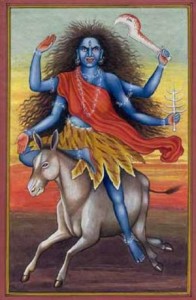
What may be the precise significance of classifying the Vidyas into ten will be a difficult question to answer. But we can indicate the following: The Supreme Mother is the Transcendent Absolute ineffable immutable. In the act of creation, she subjects herself to time and space. Though the space is actually one vast stretch, for our grasp and understanding, we demarcate the indivisible and infinite Space into ten directions, east, west, south, north, south-east, south-west, north-east, north-west, above and below. Similarly the one infinite Mother is delineated as ten outstanding personalities. Again, knowledge is one and the consciousness is one and the same everywhere. But it is grasped and understood in ten different ways by the ten senses, skin, eye, ear, tongue, nose, mouth, foot, hand, anus and genital. Likewise, the one Truth is sensed in its ten different facets; the Divine Mother is adored and approached as the ten cosmic Personalities, Dasa Maha Vidyas. Each of these ten great Vidyas is a Brahma Vidya. The Sadhaka of any one of these Vidyas attains ultimately, if his aspiration is such, the supreme purpose of life, parama purusartha viz, self-realisation and God-realisation, realizing the Goddess as not different from one’s self. All these Vidyas are benevolent deities of the highest order and so do the utmost good to the seeker of the Vidya. For anyone who takes to any of these ten Vidyas, the Sadhana proceeds on sound lines and is safe and sure. It is not necessary at the beginning for the aspirant to have as his goal the highest aim of life. His aim most probably is the fulfillment of his immediate wants and for that he approaches the Deity. Once an aspirant takes to the Deity, the Deity takes upon itself the Sadhana. This is the characteristic of these Maha Vidyas. Whatever the seeker desires the Divine Mother fulfils it. In the process his devotion to the Deity becomes stronger and stronger and he learns to look upon the Deity for even the most trivial things in life, seeks its guidance at every step and knows to wait on its grace. There starts a living concourse, a concrete intimacy between the devotee and the Deity which is so absorbing and so enthralling that all desires, all aims of the devotee with which he started the Sadhana pale into significance. The whole perspective becomes different and there comes about a change in the attitude of the Sadhaka to life and things. There come about visible signs of communion, concrete evidences of contact, irresistible proofs of the Presence and the unmistakable touches of the Divine’s gracious hand in every happening and in every circumstance. What were at one time miracles become now common-place things and the whole life becomes a happy hastening towards the Supreme Goal.
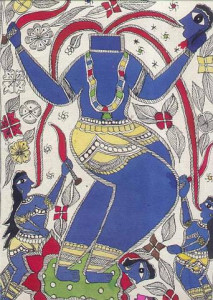
Thus nothing short of Self-Realisation, atma saksatkara is the goal of the Vidyas. Of course much depends on the seeker and on his active participation, But even if the seeker stops in the middle of the path, he does not come to any harm. Only his progress is delayed. In the Sadhana there are many pitfalls. The baser emotions may hold sway or the ego may interfere at each stage. Once an aspirant has taken to any of these ten Vidyas, he has to succeed ultimately. He may fail in the present birth. The Vidya will make him take the thread of the Sadhana in the next birth and will continue to give the necessary push to the soul of the aspirant on its onward march. Even one step forward in the path of these Vidyas goes a long way towards the Goal. Nothing goes in vain. In fact, the Tantra categorically declares that only those who have been sufficiently prepared in the previous births can approach the precincts of these Vidyas. For them alone are these well-proven carefully laid-out paths. They are the chosen ones, the men with a mission, the indefatigable toilers on the uphill path of these disciplines of knowledge.
Because all these Vidyas lead to the ultimate Reality, it does not mean that they are all one and the same. Each Vidya is distinct and distinguishable from the Other. Each is a particular Cosmic function and each leads to a special realization of the One Reality. The might of Kali, the sound-force of Tara, the beauty and bliss of Sundari, the vast vision of Bhuvaneshwari, the effulgent charm of Bhairavi, the striking force of Chinnamasta, the silent inertness of Dhumavati, the paralysing power of Bagalamukhi, the expressive play of Matangi and the concord and harmony of Kamalatmika are the various characteristics, the distinct manifestations of the Supreme Consciousness that has made this creation possible. The Tantra says that the Supreme can be realised at these various points. According to one’s ability and aptitude, one realises the great Goddess, becomes identified with her in her might, in her striking force, in her paralysing power or in her beauty and bliss, in her concord and harmony. If one wants to bathe in a river, one cannot bathe in the whole river; one has to bathe at a spot. Similarly if an aspirant wants to reach the Divine, circumscribed as he is by his receptivity and capacity, he chooses one particular path, takes up for adoration one aspect of the Divine. As his pursuit is exclusive, his progress is quick and his approach becomes direct. Ultimately he attains a perfect identification with the Divine.
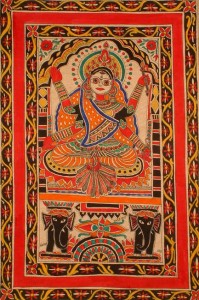
But it is not the intention of the Tantra to limit the capacity of the individual to a particular realisation however perfect it may be. It is true that there are ten Maha Vidyas directly leading to the Supreme Truth, ten chalked out paths, safe and sure to have an immediate and direct approach. For instance if one takes to the Sadhana of the Maha Vidya, Chinnamasta, ultimately one attains a perfect identification with the Supreme. All the same it is a partial identification for Chinnamasta is one facet of the many-faceted Supreme. Not a particular realisation, but a global realisation is required to attain the Total Divine. Pursuing our analogy of bathing in a river, if one wants to have conception of the ebb and flow, the eddies and currents of a river one has to bathe at various spots in the river. This is exactly what one does when one takes a holy bath in a sacred place. For instance, in Kashi, baths in so many bathing ghats are prescribed in order that the bather may have a full realisation of the grandeur of the Divine Ganges. Similarly in these ten great disciplines of knowledge, the seeker can aspire for an integral knowledge and he may, depending on his capacity, come nearer the Total Divine, by having as many realisations as he can.
In fact, the Tantra which is justly famous as a science of synthesis holds that one Maha Vidya leads its Sadhaka to another depending on the need and aspiration of the Sadhaka. The worshipper of Kali has a unique realisation of the Divine, the Terrible. At the same time, the realisation of the Divine, the Auspiscious is available to him if he understands the concept of bhadra kali. Then he goes on to appreciate the correspondence between the other two Vidyas, Tripurasundari and Tripurabhairavi, Tripura the beautiful and Tripura the terrific. In the Sundari Vidya itself worship is prescribed for Mantrini and Dandanatha, the attendants of Lalita Tripurasundari. Mantrini is Syamala or Matangi and Dandanatha corresponds to Bagalamukhi.
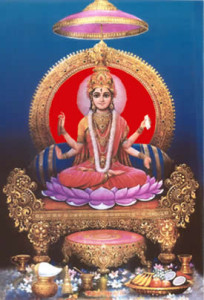
Thus the Vidya of Tripurasundari brings to the aspirant the realisations pertaining to the Vidyas of Matangi and Bagalamukhi.
Here a word of caution is necessary. When it is said that the Vidyas of Matangi and Bagalamukhi are implied in the Vidya of Sundari, the human mind immediately jumps to the conclusion that the Vidya of Sundari is superior to the other two Vidyas. The mind of man subject to the limitations of time and space can understand anything only in relation to time and space. Any new knowledge is immediately related to the old, classified and docketed as anterior or posterior, higher or lower. We reiterate that each of the ten Vidyas leads the seeker to the Supreme Reality. Each is great in its own right and each is equal in all respects to each of the other nine Vidyas. The practices of certain disciplines are widely prevalent, others are less known. For that matter they are not less important.
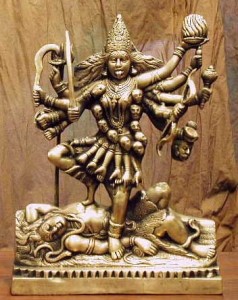
Again, an integral realisation is possible in these Vidyas because though they are distince and unique, they have among themselves many characteristics in common. Kali, Chinnamasta, Dhumavati and Bagalamukhi have the common characteristics of Power and Force, active or dormant. Sundari Bhuvaneshwari, Bhairavi, Matangi and Kamalatmika share the qualities of Light, Delight and Beauty. Tara has certain characteristics of Kali and certain others of Sundari and is correlated to Bhairavi, Bagalamukhi and Matangi in the aspect of Sound-Force expressed or impeded. Thus the ten Maha Vidyas fall into three broad divisions of discipline. The Veda lauds three Goddesses, producers of delight, tisro devir mayobhuvah. The Upanishads mention the One unborn, red, white and dark ajam ekam lohita sukla krsnam. The Tantras speak of Kali, the dark, Tara the white and Sundari the red.
In this ancient land, for ages the worship of these great mighty Personalities of the Mother has been prevalent. The other Vidyas have been practised but they have not come into the lime light. In the southern part of India the Vidya of Sundari, Sri Vidya, has been much in vogue. In the far north and north-west, in Tibet and in Kashmir adoration of Tara is popular. In the north-east parts of the country, especially in Bengal, the cult of Kali is famous. Thus the whole of India is full of adoration for the Divine Mother and the spirit of India has been eternally sustained by the Force Supreme, para sakti. The might of Kali, the wisdom of Tara and the beauty of Sundari have forged and fashioned this ancient race where the first man, the offspring of manu, the thinker, dared to peer with his earthly eyes into the portals of the Beyond.
~ by S. Shankaranarayanan

